| Volume
82
August 17-Sept. 4, 2002
Santa Rosalia (plus a trip Southern California)
Santa Rosalia was a surprise.
After miles and miles of deserted and arid
coastline, the town of Santa Rosalia springs up as a sprawling hillside
of
houses and greenery.
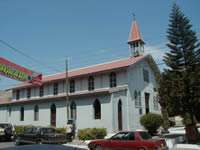 Because
it was built by the French, who started a copper mine here in the
mid 1800s, the town has a completely different look than other Baja
communities. The houses and stores of "downtown" are built
of wood, much of which was imported here by the mining company around
the Horn by square rigger! They even imported an entire church,
one designed by Alexander Gustav Eiffel (of Eiffel Tower fame).
The church, made of prefabricated steel, was displayed along with
the Tower at the 1889 Paris Expo. Then it was dismantled and shipped
out to be reassembled here! Because
it was built by the French, who started a copper mine here in the
mid 1800s, the town has a completely different look than other Baja
communities. The houses and stores of "downtown" are built
of wood, much of which was imported here by the mining company around
the Horn by square rigger! They even imported an entire church,
one designed by Alexander Gustav Eiffel (of Eiffel Tower fame).
The church, made of prefabricated steel, was displayed along with
the Tower at the 1889 Paris Expo. Then it was dismantled and shipped
out to be reassembled here!
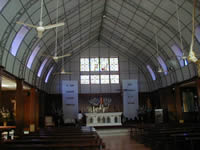 The
church is the centerpiece in a town which sorts itself out primarily
around an "Up street" and a "Down Street" along
the center of a wide arroyo. On the bluffs above the arroyo are
more buildings including the Hotel Frances, which was built in 1886,
and a hospital. "Urban sprawl" extends the town along
the flat shelf of the shoreline, with MX#1 passing through. A spacious,
rectangular man-made harbor protected by substantial stone jetties
fronts the town's center at one end and the skeletal remains of
the copper smelting operation at the other. Abandoned warehouses
and industrial structures, made even more neglected by the ravages
of several hurricanes, loom over the harbor, which now contains
a tiny ten-slip marina, a ferry pier and a veritable navy of fishing
pangas. The copper mining operation that built the town shut down
in the 1970s, and judging from the extent of the infrastructure,
its departure must have left a major hole in the local economy.
Yet the town seems one of the most vibrant and attractive we have
seen. The populace is well-dressed and lively, thronging busy tiendas,
tacquerias, restaurants, and there is even a bakery with French-style
boules. Old mine shafts have been turned into storage sheds for
those whose homes back up on them, old ore cars transformed into
planters, and the major intersection sports an old mining locomotive
as a monument to the past. The town's greenery does not owe to its
being some natural oasis, but instead to the determination and care
of the community. Several times a week a municipal truck makes the
rounds with barrels of water which are used to water trees and patches
of grass! This is an expense which impressed us! The
church is the centerpiece in a town which sorts itself out primarily
around an "Up street" and a "Down Street" along
the center of a wide arroyo. On the bluffs above the arroyo are
more buildings including the Hotel Frances, which was built in 1886,
and a hospital. "Urban sprawl" extends the town along
the flat shelf of the shoreline, with MX#1 passing through. A spacious,
rectangular man-made harbor protected by substantial stone jetties
fronts the town's center at one end and the skeletal remains of
the copper smelting operation at the other. Abandoned warehouses
and industrial structures, made even more neglected by the ravages
of several hurricanes, loom over the harbor, which now contains
a tiny ten-slip marina, a ferry pier and a veritable navy of fishing
pangas. The copper mining operation that built the town shut down
in the 1970s, and judging from the extent of the infrastructure,
its departure must have left a major hole in the local economy.
Yet the town seems one of the most vibrant and attractive we have
seen. The populace is well-dressed and lively, thronging busy tiendas,
tacquerias, restaurants, and there is even a bakery with French-style
boules. Old mine shafts have been turned into storage sheds for
those whose homes back up on them, old ore cars transformed into
planters, and the major intersection sports an old mining locomotive
as a monument to the past. The town's greenery does not owe to its
being some natural oasis, but instead to the determination and care
of the community. Several times a week a municipal truck makes the
rounds with barrels of water which are used to water trees and patches
of grass! This is an expense which impressed us!
Riccardo, the
dockmaster of the tiny Santa Rosalia Marina, told me that much of
today's income comes from squid fishing. When I wondered how much
squid the world could take, he assured me that the cannery has a
steady market in Japan! We have also been told that there is another
gypsum mine (like Isla San Marcos, see Update
#81) in the hills to the north of town.
From the cruiser's
point of view, Marina Santa Rosalia is the only marina on the Baja
side of the Sea north of La Paz. With only ten slips available and
a policy of no reservations, we were anxious that we would get the
space we needed to leave the boat for a week's jaunt by bus up to
Southern California to visit Don's daughter and to attend some friends'
wedding. Most of the boats in the marina when we pulled in had been
there between one and three months, kept there by a mix of the town's
charm and the marina's convenience and affordability. Our slip was
a little over half what a slip in La Paz cost us, and water and
electric were included. For us, the only boat with air conditioning,
this was a major benefit, for it was HOT, HOT, HOT while we were
in Santa Rosalia. We have only used the air conditioning three times
since we installed it in Trinidad, and of all the refit we did to
the boat, it has been the one effort we think was a waste. But BOY
OH BOY, did we appreciate it as well as the big forward awning,
which has been used about as rarely. Between the two of them, T2's
salon was the place to be!
Although the
marina was, in all honesty, slightly dilapidated, it had more going
for it than many a marina we've seen. Every body in the marina had
the daily habit of assembling around three in the afternoon at "The
Yacht Club," a euphemism for the marina's office space which
was housed in the still-standing end of a partially collapsed warehouse.
Inside, the office had restrooms, showers, a washer and drier, a
book-swap shelf, and, most importantly, two glass-fronted coolers
of well-chilled beer and soda. At three o'clock, the sun was just
far enough over the building to cast a shadow into which the cruisers
could move out tables and chairs for an extended happy hour of dominoes,
cold beverages and shade. Occasionally this would lead to a potluck
supper, or sometimes groups would head off to a restaurant. In short,
once settled in, it could be a very hard place to leave.
Fortunately, we had a
schedule to keep. Three days after arriving, we left
the boat in the care of our newest best friends and boarded the
ABC express
bus for Tijuana. Our experience with Latin American bus systems
has been
consistently positive. From Ecuador to Mexico (with the exception
of Costa
Rica) the buses have been spacious and punctual (the Costa Rica
bus was
miserably cramped), and the ABC bus was the best of the bunch. The
trip
took 13 hours and we saw some great scenery north of Santa Rosalia,
where MX
Highway 1 turns inland and climbs through precipitous gorges to
a smooth
plain marked by a giant conical volcano and the slope to the Pacific
Coast.
Not long after it got dark and amazingly cool, about which time
we crossed
from the state of Baja California Sur into Baja California Norte
and set our
watches back an hour.
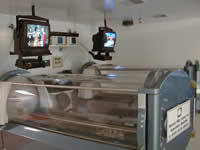 The
trip really was not bad. Even when our bus broke down, we calmly
moved aboard the next bus when it came along, --no fuss, no muss
-- still getting in Tijuana about the time we had expected! The
weirdest part of the trip for us was the military checks. There
were three of these, and they occurred on dark stretches of road
lit only by signal flares. All the passengers, most still benumbed
with sleep, would disembark and the armed soldiers would make a
show of randomly checking luggage and carry-ons. In Tijuana we changed
to an all-American Greyhound bus (less legroom) to cross the border
into San Diego. Our driver, by name of Dave, was the warmest, most
hospitable welcoming committee you could want. On Mexican busses
you are lucky if the driver even announces the name of the stop,
and the passengers are uniformly subdued. Dave, by comparison, chatted
up all his passengers all the way to San Diego! The US becomes the
US very abruptly. McDonalds, Kentucky Fried and Payless Shoes throng
the highway as well-planned shopping centers and landscaped condo
communities unfold one after the other. Indeed, the whole landscape
acquires a designed look that is really noticeable after Mexico.
We couldn't help but reflect on the huge financial investment that
underlies all this design that we Americans (and in particular Californians)
totally take for granted. The
trip really was not bad. Even when our bus broke down, we calmly
moved aboard the next bus when it came along, --no fuss, no muss
-- still getting in Tijuana about the time we had expected! The
weirdest part of the trip for us was the military checks. There
were three of these, and they occurred on dark stretches of road
lit only by signal flares. All the passengers, most still benumbed
with sleep, would disembark and the armed soldiers would make a
show of randomly checking luggage and carry-ons. In Tijuana we changed
to an all-American Greyhound bus (less legroom) to cross the border
into San Diego. Our driver, by name of Dave, was the warmest, most
hospitable welcoming committee you could want. On Mexican busses
you are lucky if the driver even announces the name of the stop,
and the passengers are uniformly subdued. Dave, by comparison, chatted
up all his passengers all the way to San Diego! The US becomes the
US very abruptly. McDonalds, Kentucky Fried and Payless Shoes throng
the highway as well-planned shopping centers and landscaped condo
communities unfold one after the other. Indeed, the whole landscape
acquires a designed look that is really noticeable after Mexico.
We couldn't help but reflect on the huge financial investment that
underlies all this design that we Americans (and in particular Californians)
totally take for granted.
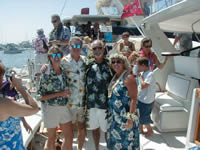 In
San Diego we got a first-hand look at the Mexican cruiser's most
important stateside link, Downwind Marine. Downwind Marine has made
a business out of catering to West Coast cruisers headed south.
It seems like everyone from Alaska and Canada south through Washington,
Oregon and the local Californians pass through here if headed to
Mexican waters. Once down here, you can order just about anything
you need by email; with your credit card on file, Downwind acquires
it, packs it up and finds someone driving down Baja to deliver it
to you….eventually. This "Baja Express," as it is
known, is how we acquired our new LAVAC toilet back in Puerto Escondido.
The fact that nearly all communities in Baja are on the MX #1 (which
snakes back and forth across the peninsula) makes this system feasible.
Actually seeing the store firsthand -where we were welcomed royally
-made us feel like "REAL" West Coast cruisers instead
of mere Eastern pretenders! Incredibly, while there, we ran into
three people we knew, one of whom had just driven up from El Salvador!!!! In
San Diego we got a first-hand look at the Mexican cruiser's most
important stateside link, Downwind Marine. Downwind Marine has made
a business out of catering to West Coast cruisers headed south.
It seems like everyone from Alaska and Canada south through Washington,
Oregon and the local Californians pass through here if headed to
Mexican waters. Once down here, you can order just about anything
you need by email; with your credit card on file, Downwind acquires
it, packs it up and finds someone driving down Baja to deliver it
to you….eventually. This "Baja Express," as it is
known, is how we acquired our new LAVAC toilet back in Puerto Escondido.
The fact that nearly all communities in Baja are on the MX #1 (which
snakes back and forth across the peninsula) makes this system feasible.
Actually seeing the store firsthand -where we were welcomed royally
-made us feel like "REAL" West Coast cruisers instead
of mere Eastern pretenders! Incredibly, while there, we ran into
three people we knew, one of whom had just driven up from El Salvador!!!!
Don's daughter
Tiffany collected us at Downwind Marine and from there patiently
chauffeured us around all week as we ticked off all the items on
a TO DO list that stretched from San Diego to LA! We won't bore
you with the details, except to remind you to look around and appreciate
the bounty that surrounds you. I about swooned in Costco.
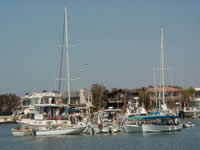 We
did squeeze in a visit to a diving physician, required before I
could resume diving after my bout with decompression sickness in
July. We finally got an appointment with a doctor - Dr. Ralph Potkin
(in pricey Beverly Hills) and were amazed to find in his fourth
floor suite a state-of-the-art hyperbaric treatment center. Instead
of the steel cylinder I "went down" in with my attendant,
in Dr. Potkin's office each patient slides solo into a glass tube
(awfully reminiscent of some sci-fi movie) with color TV outside
and piped in sound! The attendant is outside, and it was explained
to us that in a medical emergency, the patient could be returned
to surface pressure very quickly (an issue of physics I don't quite
understand.) There were, if I remember correctly, two separate "chambers',
used mostly for hyperbaric treatment of burns and other medical
needs as opposed to scuba diving accidents. Oddly, for me those
glass canisters seemed more claustrophobic than the womb-like tank
in Cabo, but the attendant assured me most patients prefer it. We
did squeeze in a visit to a diving physician, required before I
could resume diving after my bout with decompression sickness in
July. We finally got an appointment with a doctor - Dr. Ralph Potkin
(in pricey Beverly Hills) and were amazed to find in his fourth
floor suite a state-of-the-art hyperbaric treatment center. Instead
of the steel cylinder I "went down" in with my attendant,
in Dr. Potkin's office each patient slides solo into a glass tube
(awfully reminiscent of some sci-fi movie) with color TV outside
and piped in sound! The attendant is outside, and it was explained
to us that in a medical emergency, the patient could be returned
to surface pressure very quickly (an issue of physics I don't quite
understand.) There were, if I remember correctly, two separate "chambers',
used mostly for hyperbaric treatment of burns and other medical
needs as opposed to scuba diving accidents. Oddly, for me those
glass canisters seemed more claustrophobic than the womb-like tank
in Cabo, but the attendant assured me most patients prefer it.
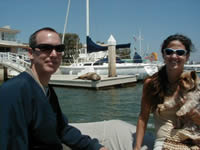 On
Sunday we drove to Newport Beach for the wedding of our friends
Jerry and Kathy of the sailing vessel Po Oino Roa, whom we first
met in El Salvador and with whom we transited the Gulfo de Tehuantepec.
Their wedding took place on a four-boat raft-up in Newport Harbor,
which is lined with multi-million-dollar beach homes. You may remember
that Jerry and Kathy bought the Kelly Peterson 44 on the East Coast
and, when we met them, were sailing it back to their Newport home
base for a major refit before heading for the South Pacific. Since
both of them grew up in the area, the raft-up was teeming with a
huge crowd of local buddies and nary a cruiser but us. The ceremony
was short but touching, the bride and groom bedecked in tropical
attire and orchid leis from Hawaii. They nearly roped us in to a
double ceremony, knowing that we've got it on the "To Do"
list and just wanting to help. We resisted, but the bug must have
been planted, because several days later we found ourselves setting
a date…but that's another story. Tiffany & Derek were
invited too, so we took a break from the festivities to tour the
harbor in Po Oino's dinghy. Definitely a high-rent neighborhood. On
Sunday we drove to Newport Beach for the wedding of our friends
Jerry and Kathy of the sailing vessel Po Oino Roa, whom we first
met in El Salvador and with whom we transited the Gulfo de Tehuantepec.
Their wedding took place on a four-boat raft-up in Newport Harbor,
which is lined with multi-million-dollar beach homes. You may remember
that Jerry and Kathy bought the Kelly Peterson 44 on the East Coast
and, when we met them, were sailing it back to their Newport home
base for a major refit before heading for the South Pacific. Since
both of them grew up in the area, the raft-up was teeming with a
huge crowd of local buddies and nary a cruiser but us. The ceremony
was short but touching, the bride and groom bedecked in tropical
attire and orchid leis from Hawaii. They nearly roped us in to a
double ceremony, knowing that we've got it on the "To Do"
list and just wanting to help. We resisted, but the bug must have
been planted, because several days later we found ourselves setting
a date…but that's another story. Tiffany & Derek were
invited too, so we took a break from the festivities to tour the
harbor in Po Oino's dinghy. Definitely a high-rent neighborhood.
We got back
safely to Santa Rosalia with all our loot and found the boat as
we left her, the weather still hot and humid, and most of the "yacht
club members" still in place. Taking advantage of the air conditioning,
we hung out in the marina nearly a whole week, installing most of
the stuff we'd brought back (including a second LAVAC toilet for
our aft head -- this is a good piece of equipment!!!!) and provisioning
for the next leg. Oh,yeah…and playing dominoes.
|








